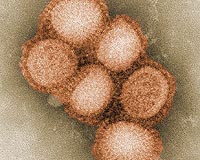| . |  |
. |
Paris (AFP) Aug 24, 2009 People who die after getting swine flu are up to 100 times more likely, compared to seasonal flu, to have been killed by the virus itself rather than secondary causes, a top French researcher said Monday. The findings -- published on a research-sharing platform, PLoS Currents: Influenza, vetted by flu experts -- could help health officials manage critical care resources if infection rates climb in the Northern Hemisphere's autumn and winter. It could also provide important clues as to the new swine flu's potential virulence, said author Antoine Flahault, a leading epidemiologist and director of France's School for Advanced Studies in Public Health. "The direct lethality due to viral pneumonia probably gives the best estimate of an influenza strain's virulence, since it may vary from strain to strain and is not due to a country's level of health development," he said. With regular seasonal flu, which claims up to 500,000 lives each year worldwide, most deaths are attributed either to secondary bacterial infections such as pneumonia, or pre-existing chronic conditions that boost vulnerability. Only about one-in-a-million infections result in death due to a rare condition known as acute respiratory disease syndrome (ARDS). "ARDS is frighteningly lethal -- it is like drowning," Flahault told AFP by phone. The condition requires intensive-care treatment for an average of thee weeks. "Statistically, only one in two patients survive." The risk factors for ADRS are poorly understood, though recent studies in the United States suggest that, among people infected with swine flu, pregnant women and the very obese are particularly at risk. Both seasonal influenza and the new A(H1N1) virus that has swept the globe since May appear to have roughly the same mortality rate of one-to-five per 1,000 infections, though figures for the swine flu remain very sketchy. Experts also caution that the pandemic flu could become more lethal as it continues to mutate. But preliminary analysis of infection and mortality statistics from the French territory of New Caledonia and the Indian Ocean island nation of Mauritius suggest that the new A(H1N1) virus directly caused an ARDS fatality for every 10,000 cases, Flahault told AFP. In New Caledonia, local health authorities have reported 30,000 infections and two deaths attributed directly to the pandemic virus. Flahault said that some 70,000 persons have been infected in Mauritius, with seven reported deaths from ARDS, five of them confirmed. "These surveillance data allow for a first estimate of direct lethality due to H1N1 of one-per-10,000 infections, about 100 times more than regular seasonal flu," he said. Flahault cautioned that these are only "preliminary and rough estimates," and acknowledged that his findings -- based on a limited number of cases on two isolated islands -- may not extend to much larger, continental countries. "But we have a terrible lack of data," he said. "It may be useful to deliver such estimates ... as early as possible so health authorities can check availability of intensive care units and artificial ventilation devices in case of a wave of similar virulence this autumn in the northern hemisphere," he said. Share This Article With Planet Earth
Related Links Epidemics on Earth - Bird Flu, HIV/AIDS, Ebola
 Swine flu looms over global economic recovery
Swine flu looms over global economic recoveryWashington (AFP) Aug 23, 2009 The markets have begun to pop champagne over global economic recovery, but the elephant lurking in the room -- swine flu -- could trample those green shoots. Spotted just four months ago, the new A(H1N1) influenza virus spread by June into a global pandemic and experts warn it could take a toll on productivity and financial systems, depending on the severity of outbreaks. About 1,800 ... read more |
|
| The content herein, unless otherwise known to be public domain, are Copyright 1995-2009 - SpaceDaily. AFP and UPI Wire Stories are copyright Agence France-Presse and United Press International. ESA Portal Reports are copyright European Space Agency. All NASA sourced material is public domain. Additional copyrights may apply in whole or part to other bona fide parties. Advertising does not imply endorsement,agreement or approval of any opinions, statements or information provided by SpaceDaily on any Web page published or hosted by SpaceDaily. Privacy Statement |